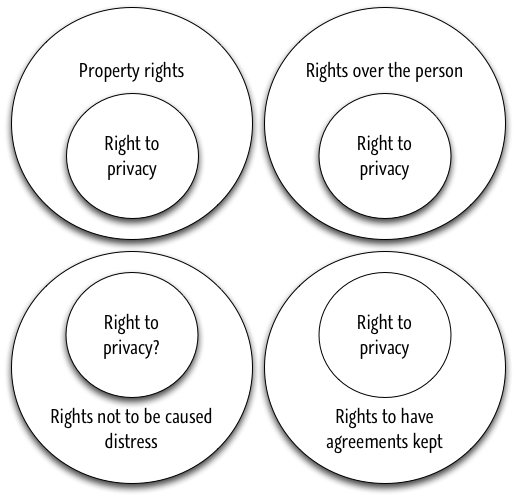
We talked about Thomson’s “simplifying hypothesis” that the right of privacy is not a distinct right on its own but is rather derived from other rights.
Here’s an illustration of the simplifying hypothesis: privacy shows up as a subset of other rights. The hypothesis is that it only shows up within other rights and never on its own.

You might ask, “so what do all the little privacy circles have in common, such that it makes sense to use the same word for them?” I think Thomson would say that there is no illuminating answer to that question. The simplifying hypothesis simplifies the right to privacy by giving up on the attempt to identify a distinct, unified right to privacy. The idea is that it it more accurate to describe the wide array of cases we put on the board last time as instances of other rights than it is to try to squeeze them into one box.
Even though she despairs of a unified theory of privacy rights, Thomson does think there are some useful generalizations. For instance, some of the rights that make up what we loosely call the right to privacy are rights that limit how others can acquire private information (Thomson 1975, 307–8) while others are rights governing how others can use information (Thomson 1975, 310–12).
For example, she thinks there is a general right not to be looked at and that this right is waived by a person who is walking in the street but that it is not waived by a person who is inside her house. Consequently, if you take unusual steps to look at people in their houses, like using an x-ray machine, you violate their right to privacy. This is an example of how the right to privacy governs the acquisition of information. (Similarly, property rights convey the right to prevent others from looking at things. The privacy right derived from property rights is invaded when someone tries to defeat the normal means used to prevent others from looking at one’s property, such as keeping it in your house.)
Rights governing the use of information are trickier. Thomson says that if there is such a right, it has to be derived from the right not to be caused distress. But this seems to be a merely hypothetical point for her. She thinks the right not to be caused distress is outweighed by the freedom of the press, so there is really no privacy right against publication of information in the press (Thomson 1975, 310). And she does not think that there is a right that private individuals not gossip about you, no matter how hurtful their doing so may be (Thomson 1975, 311–12).
So there is space in Thomson’s analysis for the cases that Warren and Brandeis thought were central, namely, rights to control the publication of personal information. But it is merely logical space for her.
I tried to illustrate the nature of Thomson’s position by contrasting two ways of analyzing the cases at issue.
Thomson’s way is to look for a general right from which the right to privacy is derived. Most of us think that the right to privacy includes the right not to be observed in private places, like our homes. Thomson analyzes that right as being derived from a general right not to be looked at. We waive this general right when we leave the home, she says, but retain it when we do not. Warren and Brandeis, by contrast, do not think there is a general right not to be looked at. They think there is a right to privacy which protects us from being looked at in certain places, like the home.
Similarly, many of us worry about the publication of private information. Thomson says that if there is a privacy right against the publication of person information, it is derived from a general right against being caused distress. Warren and Brandeis think that there is a specific right to privacy whose violation causes us to be distressed.
Austin, Adrian, and I expressed doubts about whether these general rights against being looked at or against being caused distress really exist.
Joaquín made a good case that there is a general right not to be looked at. He thought it was plausible to say that individuals have a right to control how others look at them. So, for instance, leering or aggressive staring could infringe on this right while normal looking is permitted by the person who is seen.
Jerry had a very expansive understanding of rights that would accommodate Thomson’s way of thinking, I believe.
Thomson, Judith Jarvis. 1975. “The Right to Privacy.” Philosophy & Public Affairs 4 (4): 295–314.